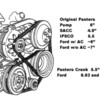Recent discussions of how the stock crank damper can shift with age got me thinking. Mine is original (72 Pre-L) and with 132,000 miles on it .. maybe I should consider a new damper. So I have a couple of questions: 1) recommendations (my engine is essentially stock BTW) with reasons. And 2) can it be installed with the engine in the car .. any installation tricks? Thanks.
Original Post


